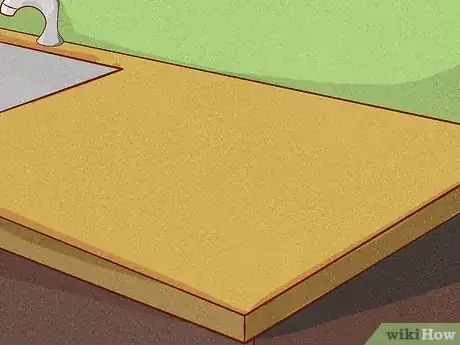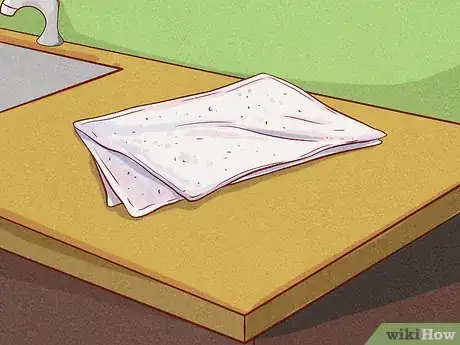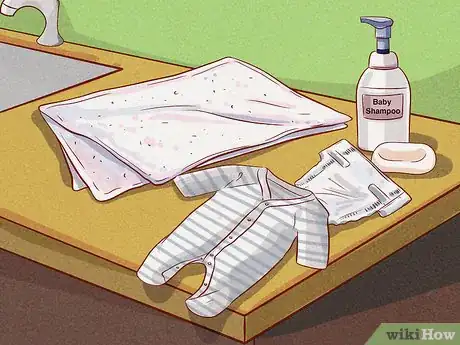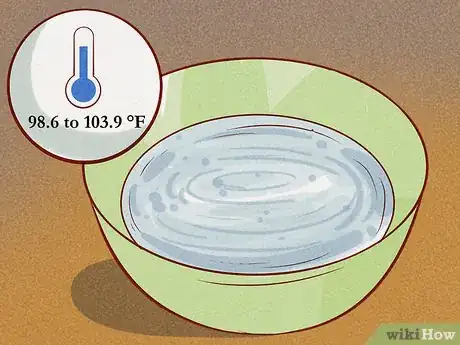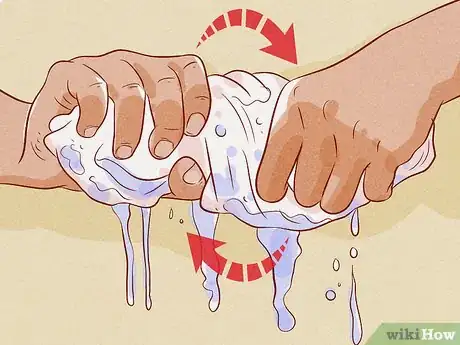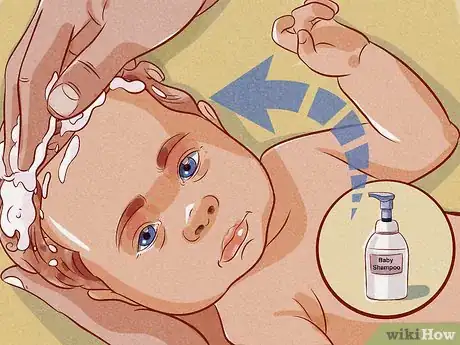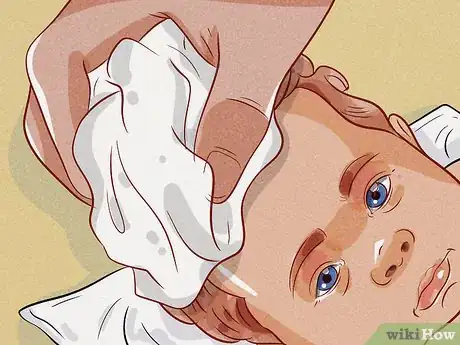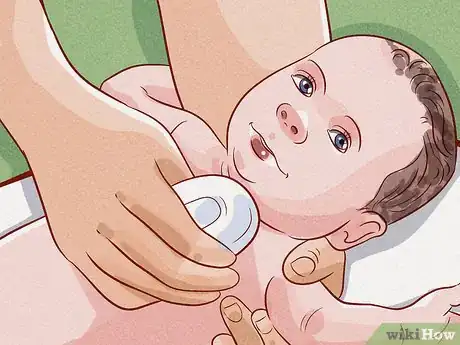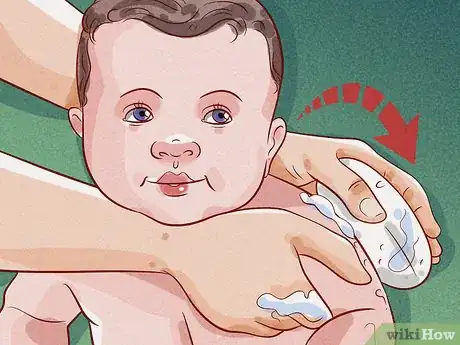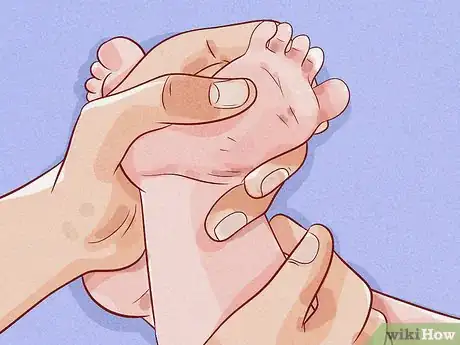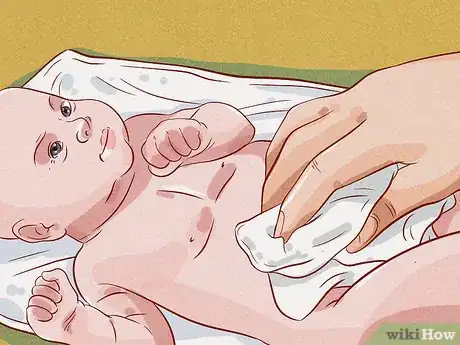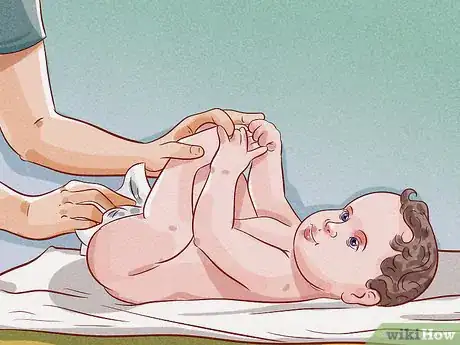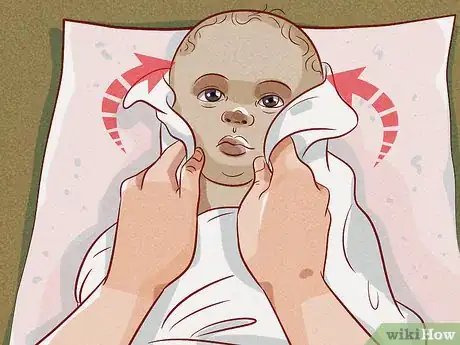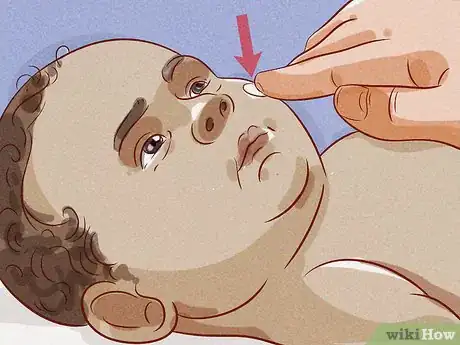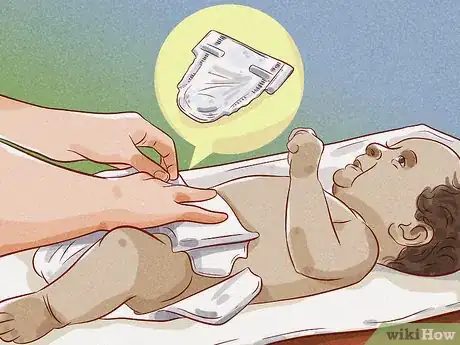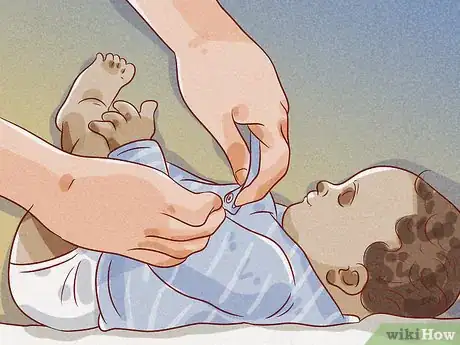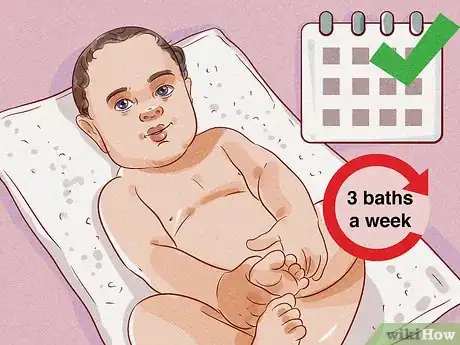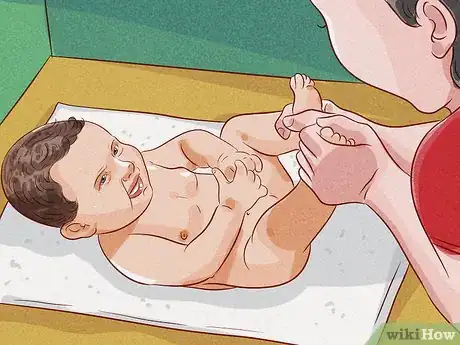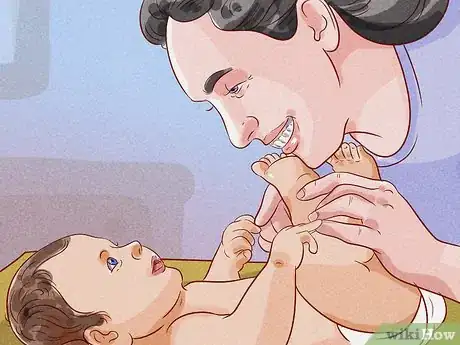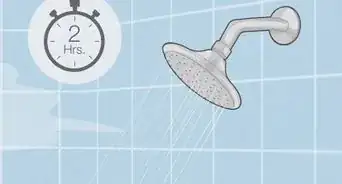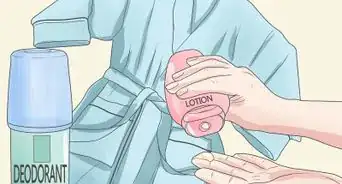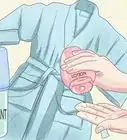This article was co-authored by Denise Stern and by wikiHow staff writer, Danielle Blinka, MA, MPA. Denise Stern is a Parenting Specialist and the CEO of Let Mommy Sleep, the country’s leading Baby Nurse and Postpartum Care service. Denise specializes in providing nurturing care to newborns and evidence-based education to their parents. She holds a BA in Public Relations from North Carolina State University. Denise was the US Chamber of Commerce Leading Woman-Owned Business in 2013, a Washington FAMILY Magazine Mother of the Year in 2016, and on the elite White House Summit for Working Families hosted by the President and First Lady Obama in 2014. Let Mommy Sleep is the only company of its kind that holds a local government contract to teach newborn and postpartum care.
This article has been viewed 11,991 times.
Bathing a baby may seem scary at first, but it can be a nice bonding experience. Until your baby’s umbilical cord falls off, you’ll need to give them sponge baths. You might decide to stick to sponge baths for several weeks after your baby is born, especially if your baby is afraid of water. Before you give your baby a bath, arrange your supplies around a flat, comfortable surface. Then, wash your baby’s face, hair, and body. After you dry them off, put on a fresh diaper and clothes. Additionally, use best practices to keep your baby safe during bath time.
Steps
Setting Up Your Bathing Spot
-
1Choose a flat surface in a warm room. Give your baby a sponge bath on a flat, comfortable surface in a room that's 75 to 80 °F (24 to 27 °C). It's best to use a flat surface so that your baby is less likely to slide off or become wedged in a crevice. Keep in mind that you won’t be submerging the baby in water, so you’ll bathe it on a towel or blanket instead. Some great places to bathe your baby include:[1]
- The kitchen counter
- The bathroom counter
- A firm bed
-
2Spread a soft blanket or towel over the flat surface to cushion your baby. Choose a soft fabric that will keep your baby comfortable. For instance, you might use a baby blanket or a plush towel. If the surface you’re using is hard, like a countertop, you might even layer the towels and blankets so your baby is very comfortable.[2]
- The towels and blankets will also help you avoid making a mess while you’re bathing your baby. They’ll soak up any water that drips off of the baby or your washcloth.
Advertisement -
3Set a towel, washcloth, baby shampoo, baby soap, diaper, and clothes nearby. Arrange all of the supplies you’ll need to wash your baby where you can easily reach them during the bath. Once you start washing your baby, you cannot leave to retrieve an item, so collect any supplies you think you may need.[3]
- Baby shampoo and baby soap are optional, but you might decide to use them if you’re worried that water alone won’t get your baby clean. If you do decide to use them, choose a mild shampoo or soap that’s clearly labeled for use on babies.
-
4Fill a nearby sink or container with warm water. Since you’re not putting your baby in the water, you can any container that’s clean for your warm water, or take it directly from the sink. If you're using a container, make sure it's within arm's reach of your bathing station. Before you bathe your baby, feel the water with your hand to make sure it’s warm but not hot.[4]
- For instance, you might use a plastic bin, large mixing bowl, or the kitchen sink.
- If you have a bath thermometer, check that the water is around 98.6 to 103.9 °F (37.0 to 39.9 °C).[5]
Tip: During a sponge bath, you won’t put your baby inside the tub of water, so you don’t need a baby bathtub. You can use whatever container is most convenient for you.
-
5Undress your baby and place them onto the towel or blanket. Wait until you’re ready to start the bath to undress your baby, as they may get chilled. Babies lose heat quickly and aren't able to regulate their temperature as well. Immediately after you undress your baby, place them directly onto the towel or blanket, and make sure they stay comfortable.[6]
- Rearrange the towel or blanket if you need to so that your baby is more comfortable.
-
6Wrap the towel or blanket around your baby to keep them warm. Your baby needs to be wrapped at all times so that they don’t get too cold. As you bath your baby, only expose the area you’re washing. As soon as that area is washed, cover it back up so your baby stays warm.[7]
- Don’t cover your baby’s face at any time during the bath.
Washing Your Baby’s Face and Hair
-
1Wet your washcloth, then wring out the excess water. Dip the washcloth into the bin of water, then squeeze it in your hand to wring out the excess water. You want the washcloth to be damp, but not dripping. This allows you to clean your baby without getting the towel or blankets wet.[8]
- Using too much water to bathe your baby can actually dry out their skin, so a damp rag is best.
Tip: It’s best to use a washcloth that’s only used for washing your baby. Otherwise, make sure your rinse it well prior to your baby’s sponge bath so that there’s no soap residue from your regular soap.
-
2Clean your baby’s face with the washcloth and just water. Gently wipe your baby’s face with the washcloth, making soft strokes. When you clean your baby’s eyes, wipe from the inside corner to the outside corner. Additionally, be sure to clean around and behind your baby’s ears.[9]
- It’s best to clean your baby’s face with water alone. If you’re being diligent about cleaning up spit up and drool, then their face shouldn’t be very dirty.
- If you use soap on your baby’s face, it could dry out their delicate skin or get into their eyes or mouth.
-
3Rub 1 drop of baby shampoo into your baby’s hair, if they have any. Wet your baby’s hair by wiping it with the washcloth. Then, put a tiny drop of mild baby shampoo onto your baby’s scalp. Gently work the shampoo into the hair and scalp using the pads of your fingers.[10]
- It’s okay to use just water on your baby’s hair and scalp, if you prefer.
- If you prefer to wash your baby’s hair, do it just once or twice a week.
-
4Use a wet washcloth to remove the shampoo from your baby’s hair. Use your damp washcloth to wipe away the shampoo. Make long, soft strokes that move away from your baby's face. Rinse and wring out the washcloth as needed as you clean away the shampoo. If necessary, you can squeeze a few drops of water over the baby’s scalp to help remove the shampoo, but make sure it doesn’t get on your baby’s face.[11]
- Alternatively you can use a cup to pour clear water over their hair.
- Be careful that you don’t get the shampoo in your baby’s eyes. Use your hand to shield the babies eyes when rinsing their hair. Control the water and the shampoo suds with your washcloth.
Cleaning Your Baby’s Body
-
1Wash your baby’s neck with mild soap and water. Dip your washcloth into the water, then add a drop of baby soap to the cloth. Wipe down your baby’s neck using soft, gentle strokes. Make sure you clean the folds in their skin by gently wiping under and between them with your washcloth. Rinse your cloth in the water, then use it to remove any soap residue.[12]
- Don’t leave the soapy water on your baby’s skin, as it could cause irritation.
-
2Expose and wash small areas, keeping your baby wrapped. Wash your baby’s body from top to bottom, working in small sections. When you’re ready to wash an area, uncover it and wipe it down with a soapy rag. Make soft, gentle strokes as you clean each area. Rinse the rag, then wipe down the area again to remove the soap. Finally, cover that area up and move to the next spot.[13]
- Your baby can become very cold during a bath, so don’t leave their skin exposed for too long.
-
3Pay special attention to creases and between the fingers and toes. Gently work the washcloth into your baby’s creases, folds, and crevices. Wipe the skin in soft strokes to remove any grime that's collected there. These areas are more likely to be dirty than the rest of your baby’s body. Washing them thoroughly will help keep them clean and prevent infections.[14]
- Make sure you don't leave dried food, milk, or poop in any of your baby's folds or creases. If the skin remains dirty, your baby might develop an infection.
-
4Wash around your baby’s umbilical cord stump, if they still have one. It's important to keep the skin around the umbilical cord stump clean so your baby doesn't develop an infection. However, try not to get the stump wet, as you want it to dry up and fall off. Use your washcloth to gently clean the base of the umbilical cord. As you clean around the belly button, don’t pull on the umbilical cord stump. It will fall off on its own.[15]
- If the stump gets wet, pat it dry with a towel, then fold the top of the baby’s diaper down until it air dries.
-
5Wash your baby’s diaper area last because it's the dirtiest. The diaper area likely contains germs from your baby's poop, as well as possible dried-on waste. For this reason, it's extra important to give this area a thorough cleaning. Use your washcloth to wipe around your baby’s leg creases, genital area, and bottom. Make sure you don’t leave any dried on fecal matter, which can sometimes get trapped. When you’re washing the genital area, use these guidelines:[16]
- For girls, wipe their vaginal area from front to back.[17]
- For an uncircumcised boy, don’t push his foreskin back to clean his penis. Gently clean around the area without moving the foreskin.
- For a circumcised boy, don’t clean the penis for 3 to 4 days after the circumcision. After that, squeeze a thin stream of warm water directly onto your baby’s penis to clean it. Don’t apply any soap unless your doctor tells you to do so.[18]
Drying and Dressing Your Baby
-
1Pat your baby dry with your extra towel. Gently blot away any excess water on your baby’s skin using a soft, dry towel. If you have a hooded towel, wrap the baby inside it to keep their body warm as your dry them.[19]
- Don’t rub your baby’s skin, which can irritate it.
-
2Apply a pea-size dot of unscented baby moisturizer if their skin feels dry. Most babies don’t need moisturizer. However, you can apply a tiny amount of moisturizer to your baby if their skin feels dry. Rub the lotion onto your baby’s skin to help it absorb, then wrap your baby in a towel or blanket for a few minutes while the lotion absorbs.[20]
- If your baby’s skin is dry often, you may be bathing them too often. Check with your doctor to make sure you don’t need to change your routine.
-
3Put a clean diaper on your baby. After your baby is totally dry, put on a new diaper. Make sure the diaper doesn’t go up over the umbilical cord stump, if they have one.[21]
- If your son has been circumcised, you may need to put petroleum jelly in the diaper to keep the padding from sticking to your baby. Talk to your doctor to find out if you need to do this.
-
4Dress your baby in clean clothes. Put fresh, clean clothes on your baby, then swaddle them in a blanket. Spend a few minutes cuddling your baby so that they experience baths as a calm, comforting experience.[22]
Using Best Practices for Health and Safety
-
1Bathe your baby 3 times a week to keep them clean. Your baby doesn’t need to be bathed often until they start crawling around. In fact, washing them too often can irritate their skin. Stick to just 3 baths a week.[23]
- If your baby gets very dirty after being sick or having a diaper blowout, it’s okay to give them an extra bath. However, you might consider adjusting your baby’s bathing schedule if their next bath is coming up soon.
-
2Choose a bathing time when you’re feeling unrushed and uninterrupted. Your baby will enjoy bath time more if you are calm and in a good mood. Pick a time of day that’s convenient for you so that you can go slow and give your baby the best experience possible. This will help with bonding and set your baby up to enjoy baths in the future.[24]
- Turn off your phone ringer during bath time, and ask other household members not to interrupt.
-
3Wait at least 30 minutes after a feeding before bathing your baby. Your baby’s tummy needs time to settle after a feeding, so don’t bathe them right after. Instead, wait about half an hour.[25]
- It’s helpful to create a routine so that you’re feeding your baby at a different time from their bath.
-
4Stay with your baby at all times during their bath. Although your baby won't be in the water, they still need to be watched and guarded. Your baby could roll off the flat surface or get tangled up in the towel or blanket. Make sure you’re right next to your baby the entire time, and keep your hand on them as much as possible.[26]
- Try not to worry during the bath. As long as you are there, your baby will be safe.
-
5Speak to your baby in a soothing voice throughout the bath. It’s normal for babies to be afraid and uncomfortable when they first start getting baths. Sponge baths are usually more comfortable for them, but it’s still a new experience. Give them calm encouragement and let them know that everything is okay. This will help your baby have a nice time.[27]
- Use a soft, upbeat voice, and smile a lot as you talk.
Things You’ll Need
- Flat surface
- Towels
- Washcloth
- Mild baby shampoo
- Mild baby soap
- Baby wipes
- Diaper
- Change of clothes
- Container, basin, or sink
- Warm water
- Unscented baby lotion (optional)
Warnings
- Your baby can easily become chilled while they're wet. Be sure to keep them wrapped in a towel or blanket throughout the bath.⧼thumbs_response⧽
- Don’t use hot water to wash your baby, as this might cause scalding. Make sure the water feels warm to the touch, but not too hot.⧼thumbs_response⧽
- Bathing your baby too often can dry out their skin, so only bathe your baby 3 days a week.⧼thumbs_response⧽
References
- ↑ https://www.healthychildren.org/English/ages-stages/baby/bathing-skin-care/Pages/Bathing-Your-Newborn.aspx
- ↑ https://www.mayoclinic.org/healthy-lifestyle/infant-and-toddler-health/in-depth/healthy-baby/art-20044438
- ↑ https://www.mayoclinic.org/healthy-lifestyle/infant-and-toddler-health/in-depth/healthy-baby/art-20044438
- ↑ https://www.mayoclinic.org/healthy-lifestyle/infant-and-toddler-health/in-depth/healthy-baby/art-20044438
- ↑ https://www.drugs.com/cg/sponge-bathing-your-baby.html
- ↑ https://www.mayoclinic.org/healthy-lifestyle/infant-and-toddler-health/in-depth/healthy-baby/art-20044438
- ↑ https://www.mayoclinic.org/healthy-lifestyle/infant-and-toddler-health/in-depth/healthy-baby/art-20044438
- ↑ https://www.mayoclinic.org/healthy-lifestyle/infant-and-toddler-health/in-depth/healthy-baby/art-20044438
- ↑ https://www.mayoclinic.org/healthy-lifestyle/infant-and-toddler-health/in-depth/healthy-baby/art-20044438
- ↑ https://www.mayoclinic.org/healthy-lifestyle/infant-and-toddler-health/in-depth/healthy-baby/art-20044438
- ↑ https://www.drugs.com/cg/sponge-bathing-your-baby.html
- ↑ https://www.mayoclinic.org/healthy-lifestyle/infant-and-toddler-health/in-depth/healthy-baby/art-20044438
- ↑ https://www.healthychildren.org/English/ages-stages/baby/bathing-skin-care/Pages/Bathing-Your-Newborn.aspx
- ↑ https://news.sanfordhealth.org/childrens/bathing-with-an-umbilical-cord/
- ↑ https://www.drugs.com/cg/sponge-bathing-your-baby.html
- ↑ https://news.sanfordhealth.org/childrens/bathing-with-an-umbilical-cord/
- ↑ https://www.healthychildren.org/English/ages-stages/baby/bathing-skin-care/Pages/Bathing-Your-Newborn.aspx
- ↑ https://www.drugs.com/cg/sponge-bathing-your-baby.html
- ↑ https://www.mayoclinic.org/healthy-lifestyle/infant-and-toddler-health/in-depth/healthy-baby/art-20044438
- ↑ https://www.mayoclinic.org/healthy-lifestyle/infant-and-toddler-health/in-depth/healthy-baby/art-20044438
- ↑ https://www.mayoclinic.org/healthy-lifestyle/infant-and-toddler-health/in-depth/healthy-baby/art-20044438
- ↑ https://www.mayoclinic.org/healthy-lifestyle/infant-and-toddler-health/in-depth/healthy-baby/art-20044438
- ↑ https://www.mayoclinic.org/healthy-lifestyle/infant-and-toddler-health/in-depth/healthy-baby/art-20044438
- ↑ https://www.mayoclinic.org/healthy-lifestyle/infant-and-toddler-health/in-depth/healthy-baby/art-20044438
- ↑ https://www.mayoclinic.org/healthy-lifestyle/infant-and-toddler-health/in-depth/healthy-baby/art-20044438
- ↑ https://www.healthychildren.org/English/ages-stages/baby/bathing-skin-care/Pages/Bathing-Your-Newborn.aspx
- ↑ https://www.healthychildren.org/English/ages-stages/baby/bathing-skin-care/Pages/Bathing-Your-Newborn.aspx
